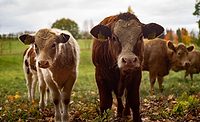CDC Estimates Human Brucella Infections Could be Four Times Higher Than Previously Thought

Image credit: Laura Ohlman via Unsplash
In a recent article published in Emerging Infectious Diseases, the U.S. Centers for Disease Control and Prevention (CDC) has estimated the global incidence of human brucellosis to be 1.6–2.1 million new cases per year, which is three to four times higher than the previous estimate of 500,000 new cases per year. Humans are normally exposed to Brucella by consuming unpasteurized milk products or handling contaminated tissues from livestock.
There are three Brucella species—B. abortus, B. melitensis, and B. suis—that are highly virulent to livestock and humans, and are considered endemic in most countries, predominantly in resource-limited settings. Although Brucella infections are a concern for livestock and are known to be zoonotic, human brucellosis is less recognized and understood.
To fill knowledge gaps about the global number of new human brucellosis cases, CDC estimated annual incidence by identifying at-risk human populations, estimating the risk for populations for which there are currently no available data, and estimating the risk of acquiring human brucellosis both globally and regionally. CDC pulled data on human brucellosis from the World Organization of Animal Health (WOAH) and human population data reported to the World Bank, specifically investigating the presence of B. abortus, B. melitensis, and B. suis among the 182 WOAH member states; the presence of human brucellosis by country as compiled by WOAH, without regard for Brucella species; and rural human population counts within WOAH countries (those with the highest likelihood of contact with livestock) from the World Bank.
The findings suggest that at least 1.6–2.1 million new cases of human brucellosis likely occur every year, which is significantly higher than one of the most cited references in the brucellosis field that predicts an incidence of 500,000 new cases annually. CDC noted that disease misdiagnosis and underdiagnosis were not factored into the study’s statistical models, which would have increased brucellosis estimates.
Additionally, CDC found that certain regions are increasingly more at-risk for Brucella infections than others; specifically, Africa due to its demand for animal products and insufficient preventive programs, and Asia due to close contact with small ruminants and consuming their raw milk products. The Americas also show a uniform spread of risk across the region with distinct hotspots. Central America has the highest risk, followed by northern and southern South America, due to the farming of cattle, small ruminants, and pigs, as well as the trade of raw milk products.
Looking for a reprint of this article?
From high-res PDFs to custom plaques, order your copy today!






